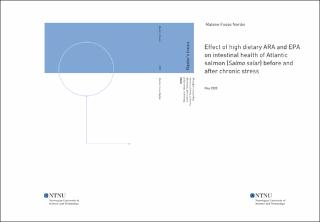| dc.contributor.advisor | Olsen, Rolf Erik | |
| dc.contributor.advisor | Løvmo, Signe Dille | |
| dc.contributor.author | Nordvi, Malene Fosse | |
| dc.date.accessioned | 2020-07-17T16:00:25Z | |
| dc.date.issued | 2020 | |
| dc.identifier | no.ntnu:inspera:56277038:22214172 | |
| dc.identifier.uri | https://hdl.handle.net/11250/2669429 | |
| dc.description.abstract | Redusert bruk av marine fettsyrer i fiskefôr har ført til en høyere n-6/n-3 fettsyresammensetning i vev og organer til Atlantisk laks (Salmo salar). Siden langkjedede flerumettede fettsyrer (LC-PUFA) har sentrale roller i mange biologiske mekanismer, kan en forandret fettsyresammensetning omdanne eikosanoidkaskadene og dermed utgjøre en stor trussel mot fiskehelse og velferd. Lite er kjent om hvordan endret sammensetning av LC-PUFA i fôr påvirker inflammasjonsprosessen og kroniske stressmekanismer i fisk. Dette studiet hadde som formål å undersøke effekten av høyt innhold av ARA og EPA i fôret på tarmhelsen til Atlantisk laks (Salmo salar) både før og etter kronisk stress. Smoltifisert Atlantisk laks ble fôret med dietter med høyt innhold av enten a) ARA eller b) EPA, med tre replikater per diett i to måneder før prøveuttak. Etter dette ble fisken utsatt for tre uker med uforutsigbart kronisk stressregime (UCS) med stressorer som ofte er funnet i oppdrettsnæringen. Tarmhelsen ble vurdert ved å bruke histologiske og immunhistokjemiske metoder for å undersøke midt- og baktarm for tegn på inflammasjon.
Høyt innhold av ARA i fôret reduserte vektøkning og spesifikk vekstrate gjennom hele forsøksperioden sammenliknet med fisk fôret med høyt innhold av EPA. I tillegg viste fisk fôret med ARA endringer i morfologien i baktarm etter to måneder med fôring. Dette korrelerte derimot ikke til oppregulering av immunceller. Tre uker med kronisk stress førte til redusert vekst i fisk fôret med begge diettene. Det ble ikke detektert en oppregulering av kortisol eller hematokritt i blodet etter kronisk stress. Det ble derimot observert et signifikant høyere hematokrittnivå i EPA fôret fisk sammenliknet med fisk fôret med ARA diett, gjennom hele eksperimentet. I tillegg ble det observert morfologiske endringer i baktarmen til både ARA og EPA fisk som konsekvens av den kroniske stress perioden, i tillegg til økt oppregulering av granulocytter i enkle folder i midttarm og komplekse folder i baktarm. Høyt innhold av ARA i fôret under stressende forhold, så ut til å forsterke de negative effektene på tarmmorfologien sammenliknet med høyt innhold av EPA. Disse dataene korrelerte ikke med økt inflammasjonsresponser som forventet gjennom regulering av immunceller. Derimot førte kronisk stress til oppregulering av MHCII celler i baktarmen og CD8 celler i midttarmen til fisk fôret med EPA diett, mens det samme ikke ble observert i de fôret med høyt innhold av ARA. Resultatene demonstrerte at endret innhold av LC-PUFA i fôret påvirker tarmhelsen til Atlantisk laks, noe som understreker behovet for utvidet forsking i dette området. | |
| dc.description.abstract | The reduced use of marine oils in fish feed has led to a higher n-6/n-3 fatty acid composition in tissues and organs of Atlantic salmon (Salmo salar). As long-chain polyunsaturated fatty acids (LC-PUFA) have central roles in many biological mechanisms, an altered fatty acid composition can change the eicosanoid cascades and pose a great threat to fish health and welfare. However, little is known about how altered LC-PUFA in feed affects the inflammatory process and chronic stress mechanisms in fish. This study aimed to examine the effect of high dietary ARA and EPA on the intestinal health of Atlantic salmon (Salmo salar) both before and after chronic stress. Smoltified Atlantic salmon received diets containing either high a) ARA or b) EPA, with three replicate tanks per diet for two months before sampling. Following this, the fish were subjected to three weeks of unpredictable chronic stress (UCS)-regime with stressors common in the aquaculture industry. The intestinal health was examined by using histological and immunohistochemical methods to investigate the mid- and hind-intestine for signs of inflammation.
High dietary ARA led to reduced weight increase and specific growth rate throughout the whole experimental period compared to feeding with high dietary EPA. Additionally, fish fed ARA diet showed changes in gross morphology in the hind-intestine after two months of feeding. This did, however, not correlate to upregulation of immune cells. Three weeks of chronic stress regime led to reduced growth in fish fed both diets. No upregulation of cortisol or haematocrit was detected after chronic stress. However, there was a significantly higher haematocrit level in EPA fed fish compared to those fed ARA diet, throughout the whole trial. Moreover, there were observed morphological changes in the hind-intestine of both ARA and EPA fed fish as a consequence of the chronic stress period, in addition to upregulation of granulocytes in mucosal folds in mid-intestine and complex folds in hind-intestine. Feeding with high ARA during the stressing conditions appeared to enhance the negative effects on the intestinal morphology compared to feeding with EPA. These data did not transform to elevated inflammatory responses as expected through regulations of immune cells. Chronic stress did in fact lead to upregulation of MHCII cells in the hind-intestine and CD8 cells in the mid-intestine of fish fed EPA, whereas the same were not observed in those fed high dietary ARA. The present results demonstrate that altered LC-PUFA affects the intestinal health of Atlantic salmon and highlight the need for extended research on this topic. | |
| dc.language | | |
| dc.publisher | NTNU | |
| dc.title | Effect of high dietary ARA and EPA on intestinal health of Atlantic salmon (Salmo salar) before and after chronic stress | |
| dc.type | Master thesis | |
